Extend Your Visa-Free Stay in Japan to 6 Months: a Step-by-Step Guide
Written on December 1st, 2024 Updated on August 1st, 2025As you might know from the article here, I am finally enjoying the benefits of being a German passport holder. One of the huge privileges it provides is being able to travel to most of the countries in the world without the hassle of getting a visa.
But if you’re heading to Japan, one little-known fact is that you can extend your visa-free stay for up to 6 months!
Which, according to my estimates, is just enough for you to get sick of even seeing ramen for the rest of your days.
 Citizens of these countries do not require a visa to enter Japan according to Wikipedia
Citizens of these countries do not require a visa to enter Japan according to Wikipedia
To enter Japan visa-free, the list of countries is not that small, 71 countries according to the Ministry of Foreign Affairs.
But for those with passports of Germany, Austria, Liechtenstein, Switzerland, Ireland, UK, and Mexico, Japan lets you extend your 90-day visa-free stay to another 90 days, making it a total of 180 days or 6 months.
Navigate this page:
- Citizens of which countries can stay in Japan for 6 months visa-free?
- Step 1. Enter the country visa-free
- Step 2. Wait for 45 days
- Step 3. Find an immigration office
- Step 4. Line up at the immigration office
- Step 5. Request the visa-free stay extension
- Step 6. Fill out the forms
- Step 7. Submit the forms and wait
- Step 8. Pay the fee
- Step 9. Get the extension stamp in your passport
- Enjoy your stay
- Can you just leave Japan and re-enter instead?
- When can you come back to Japan after the extension expires?
- The difference between staying visa-free and getting a digital nomad visa
 If you prefer digesting information in video format, this video covers everything
If you prefer digesting information in video format, this video covers everything
Citizens of which countries can stay in Japan for 6 months visa-free?
- United Kingdom
- Germany
- Switzerland
- Austria
- Ireland
- Liechtenstein
- Mexico
The up-to-date list should be on the official website here.
Without further ado, assuming you have one of the passports above, let’s jump straight into how it works and what you need to do to extend your stay in Japan.
Step 1. Enter the country visa-free
Be lucky to have one of the passports mentioned above and arrive in Japan. Legally, please :)
At the airport, they give you a nice little stamp in your passport, and you are allowed to stay for 90 days (yaaay).
You can arrive on a ferry too, of course. There is at least one that runs between Busan in Korea and Fukuoka in the South of Japan.
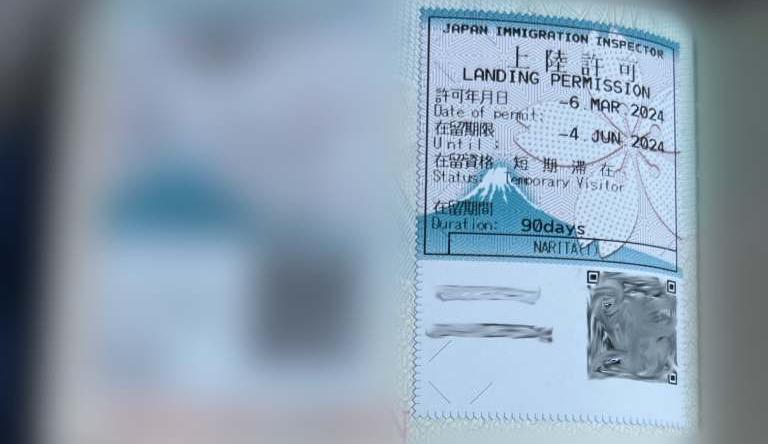 Some see the landing permit as a visa on entry (it’s not)
Some see the landing permit as a visa on entry (it’s not)
Step 2. Wait for 45 days
This is the important part I couldn’t find anywhere, or maybe I didn’t look that well.
Either way: before you do anything, you gotta wait for half of your permitted stay to pass. So, enjoy your first 45 days in the country.
 Might as well enjoy exploring the country while you wait
Might as well enjoy exploring the country while you wait
Step 3. Find an immigration office
On day 46 or later (just not on the last day of your permitted stay lol), go to the immigration office nearest to you.
The visa-free period will be extended based on the original expiration date, not the date of your visit to the immigration office. You will get your half a year in Japan anyway, so don’t sweat it about the exact date of the visit.
You can find an immigration office with my favorite app of them all: Google Maps. You can choose any office that’s closer/more convenient to you.
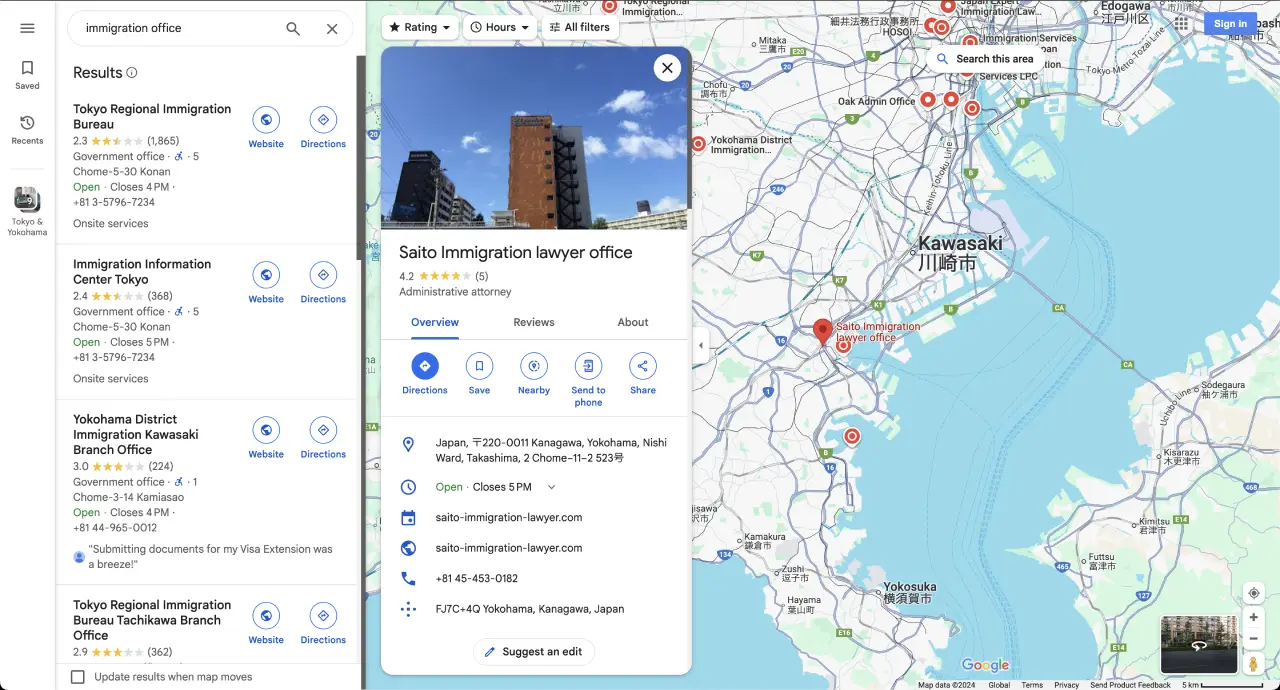 This is not what we need
This is not what we need
To find one that’s an actual immigration office and not some lawyer’s office, look for places marked as “Government office”, with the official website linked. And more importantly: check the reviews section to make sure it’s the government office.
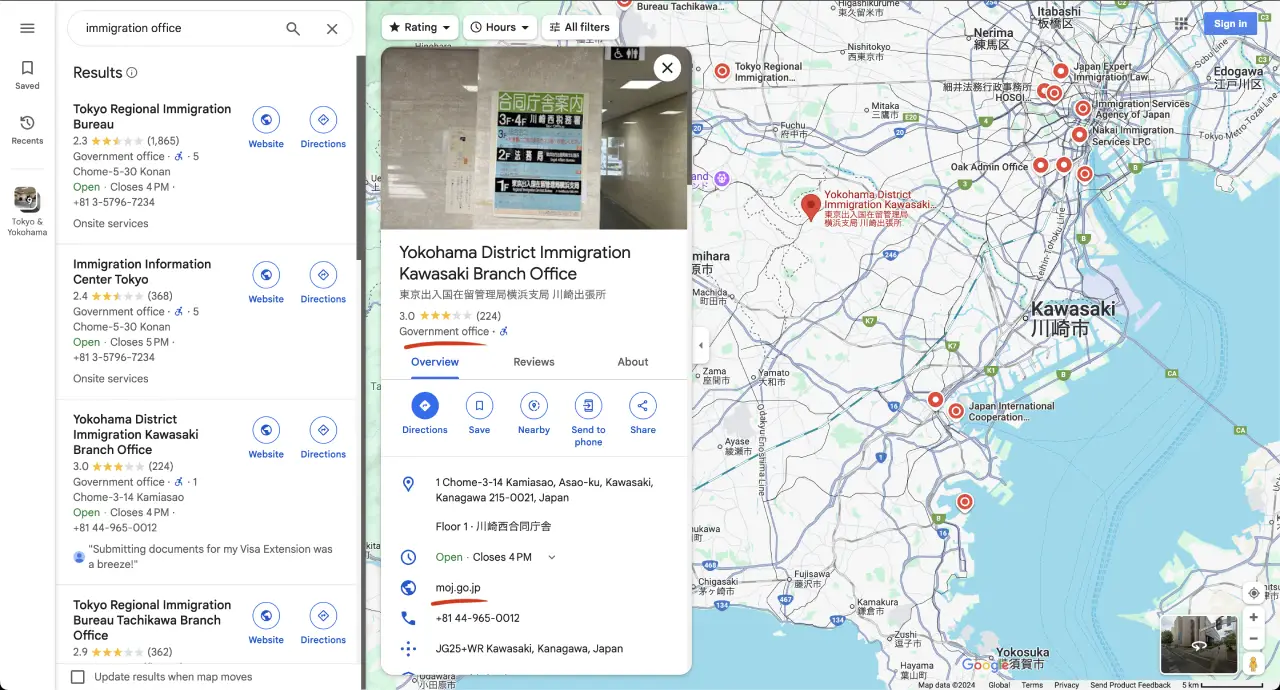 Linked official website and people complaining in reviews - we’re on the right track
Linked official website and people complaining in reviews - we’re on the right track
Step 4. Line up at the immigration office
Arrive at the immigration office to witness a huge line of 30+ people, even if you arrive 15 minutes before the office opens.
Maybe some offices are better than others, but the one I went to was always full. The good news though: the line moves quite fast, in my case it did at least.
There is one line to the “information” window. That’s where you need to line up as well.
If you’re wondering: no, there is no option to book an online appointment. And no, unfortunately, I could not find the forms you need to fill out online, although I’m pretty sure they should be somewhere.
If you find the forms, please drop a comment under this video with the information on where to find them and I’ll update this page.
Step 5. Request the visa-free stay extension
Here’s how to say it in simple Japanese:
ビザなし滞在を延長したい
Bizanashi taizai o enchō shitai
(I would like to extend my visa-free stay)
I recommend writing it down and showing it to them, along with the stamp in your passport you got at the entry.
Some of the staff might not speak English that well, so have your Google Translate ready(or ChatGPT, Gemini, or whatever translator app you’re using), in case you need help explaining yourself.
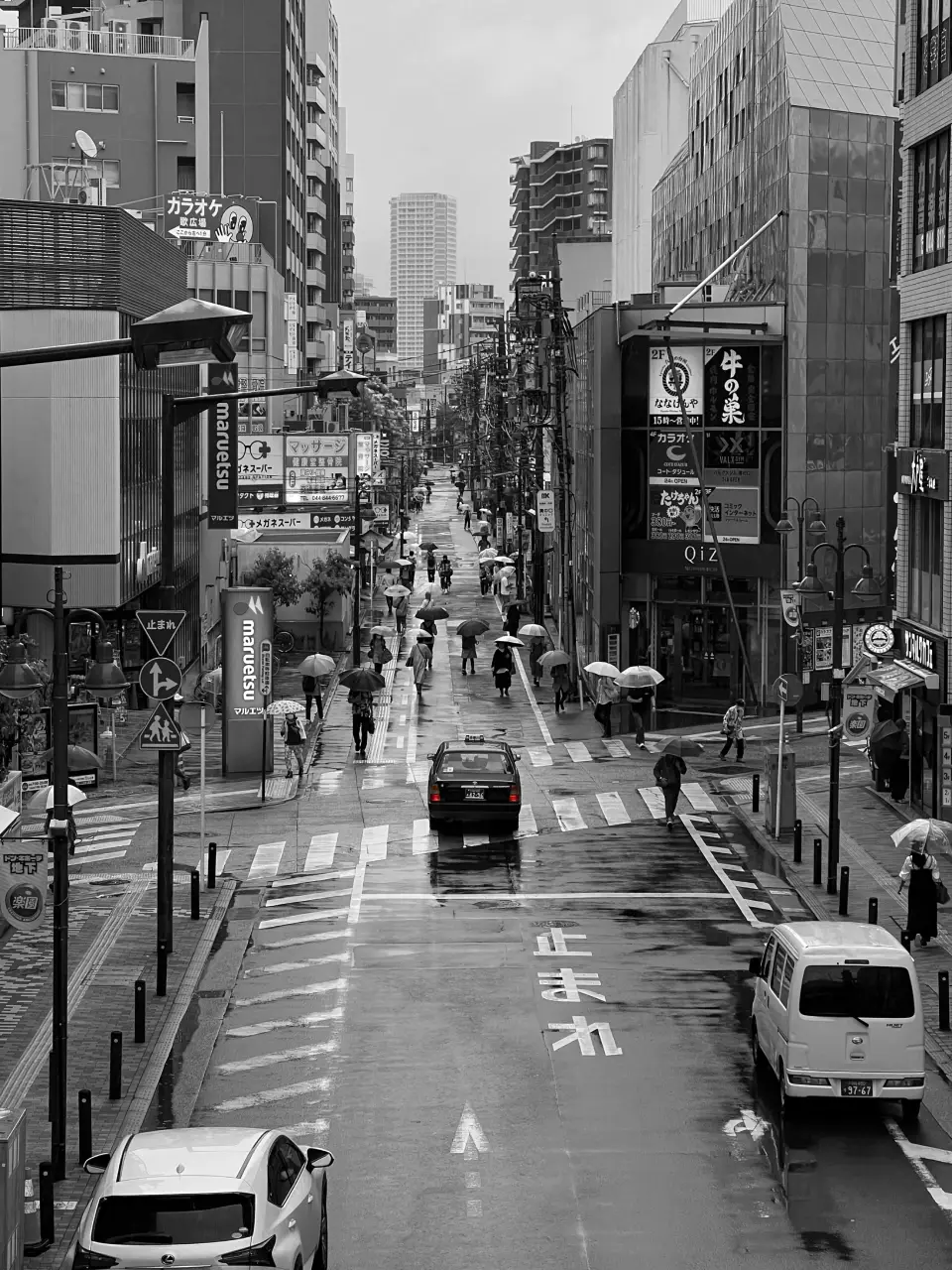 Hey, I didn’t say it will be all ponies and rainbows
Hey, I didn’t say it will be all ponies and rainbows
Step 6. Fill out the forms
If you’ve been nice like I described, they will give you the forms: 3 pages to fill out, some of them 2-sided. They will tell you the counter where to bring it once you’re done.
You need to fill out these forms in English. Most of it is trivial, you don’t need any special documents except your passport.
Questions in the forms include info like:
- your address in your home country;
- the address of where you’re staying in Japan (just specify the latest hotel);
- whether you have a criminal record;
- where have you been to in Japan so far and where you’re planning to go next;
- whether you have a return flight (I didn’t);
- how much money you have to spend (I specified 3 mln JPY), they didn’t ask for a proof or anything, but be ready to prove it if they ask, I guess;
- Nationality, meaning your citizenship, so the passport of which country you used for entry (if you have multiple), not your national identity.
One of the papers had the dedicated space marked for a photo, but they told me it’s not needed.
You’ll have about half of an A4 page to explain why you need the visa extension.
I wrote there how much I enjoyed my stay so far, and listed some of the places I still wanted to visit. I did buy a bicycle, so I specified that too and mentioned I wanted to do some bike trips as well, meet new people, etc.
Update 2025: at another office they did ask for a proof of funds, for which I printed a bank statement from my online bank.
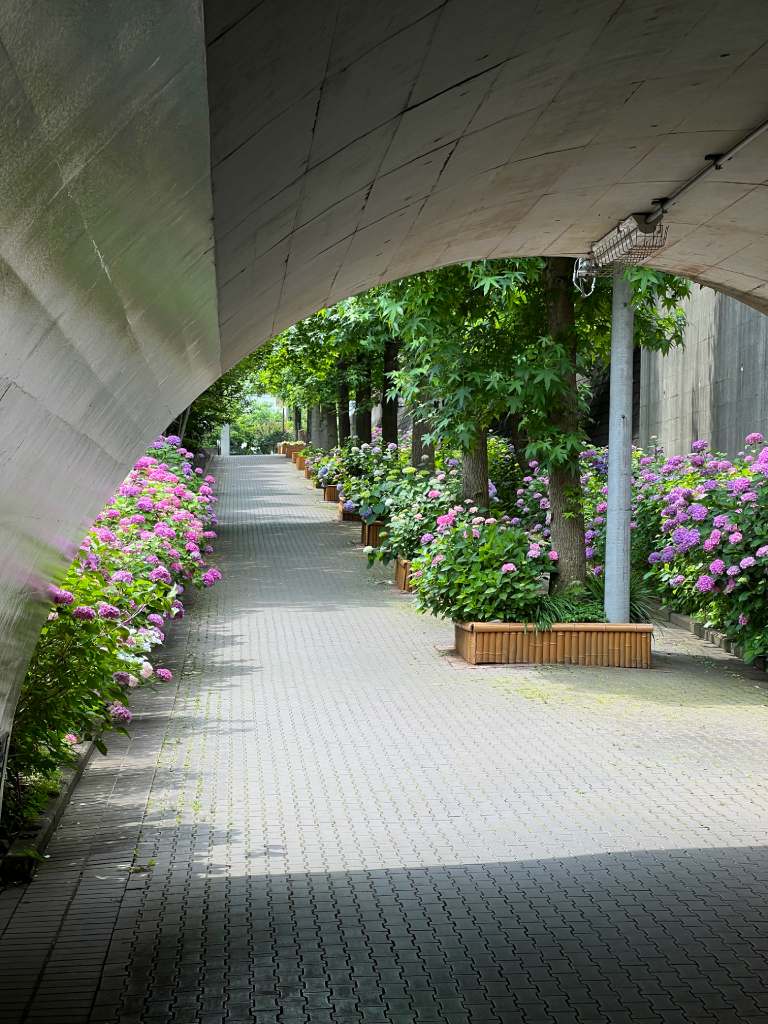 You’re almost there! There’s is a light at the end of the tunnel
You’re almost there! There’s is a light at the end of the tunnel
Step 7. Submit the forms and wait
Once you’re done filling in the forms, submit them along with your passport at the counter they told you to.
They will give you a number, which will show up on the screen when it’s your turn. In my case, there was also a QR code I could scan, and I believe a notification would be sent to my phone or email.
Since it might take a few hours, might make sense to use it, especially if there is something to do outside the office, even if it’s just chilling at a cafe nearby. Still better than sitting in a cramped office: in my case, it was one room with one fan and over 40 people in it and not enough seats for everyone.
 You can explore around while waiting
You can explore around while waiting
Step 8. Pay the fee
When it’s your turn, at the counter they will confirm that your application has been approved. I don’t think they have a lot of reasons to decline the application unless you tried to join Yakuza or something.
Make sure to bring cash, as in my case they accepted neither credit cards nor Pasmo/Suica cards.
Update 2025: you’ll have to pay 6000 yen for the application.
At the counter (that you’ll get to love so much), they’ll hand you a piece of paper that you need to take to another counter, which, of course, was on a different floor in my case (because why not).
There, you’ll pay the fee and get something called a “revenue stamp”. It looks just like a post-stamp. They’ll glue it onto the paper, completing the ceremony that confirms you paid the fee.
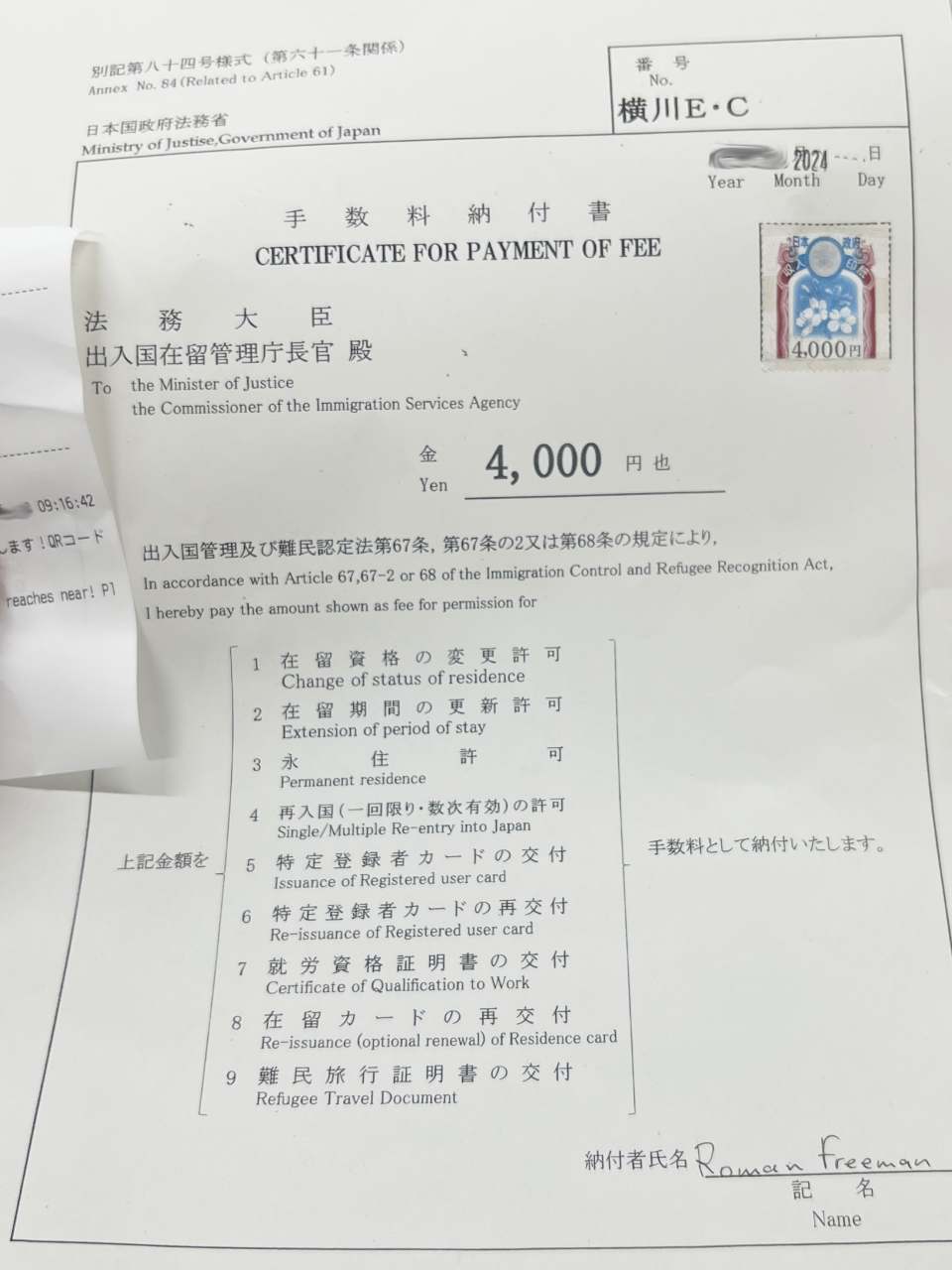 Gotta love that sweet bureaucracy
Gotta love that sweet bureaucracy
Step 9. Get the extension stamp in your passport
Once you’ve completed the epic “revenue stamp quest”, it’s time to return to the original counter where you got the papers.
Here’s the twist: there’s no waiting number this time, so I ended up standing around awkwardly for 5–10 minutes until the person who handed me the papers earlier finally appeared. They took my papers, only to hand me back the exact same waiting number I’d gotten at the start.
Of course, this meant more waiting until I was finally called again. But hey, it was all worth it in the end when they granted me the ultimate prize: permission to stay for six whole months!
It looks just like the stamp glued into your passport at the entry.
 As you can see, it includes the horrendous “final extension” stamp
As you can see, it includes the horrendous “final extension” stamp
Enjoy your stay
You’ve done it!
Now it’s time to explore what you’ve planned or just relax and enjoy your well-deserved sushi.
I recommend you check out this video where I talk about what to expect from Japan and cover some good-to-know “gotchas”, especially if it’s your first visit to the country.
 In the video, I share the top mistakes to avoid
In the video, I share the top mistakes to avoid
Can you just leave Japan and re-enter instead?
There is some bad advice going around on the Internet that you can just leave the country right before your initial visa-free period ends and re-enter, even on the same day.
And, while it seems to work for some people, it all comes down to the immigration officer you’d be dealing with at the airport.
When I asked about this at the immigration office, they even consulted a senior staff member, who confirmed that the maximum stay is 180 days per year. Meaning, an immediate re-entry might work one time.
But if you’re trying to push it over 180 days per rolling year, technically, they should not let you in.
So even though I talked to people managing to stay for a year (!) by repeatedly re-entering, I would advise against it.
Up to you, of course, but I wouldn’t want to risk getting stuck at the airport, having to buy an expensive flight out of the country, or worse: a record in my passport.
That could come back to haunt you, especially when visiting countries with stricter immigration policies, like the U.S.
When can you come back to Japan after the extension expires?
As discussed above, the maximum visa-free stay in Japan is 180 days per rolling year.
At the immigration office, I explicitly asked, if I could come back earlier one way or another, and the answer was: without a visa, you can’t.
Another thing to consider: in many cases, if you’re staying in any given country over about 180 days in a rolling year, you’re becoming tax liable in that country.
 It’s so worth going back though
It’s so worth going back though
The difference between staying visa-free and getting a digital nomad visa
There is another option to stay in Japan for half a year: the Digital Nomad Visa.
Here are the main differences:
-
Visa-Free Stay: your activities, legally speaking, are strictly limited to tourism, short-term business, or visiting friends/family. You cannot work, even remotely, while on a visa-free stay. Your country must be on the shortlist to be eligible.
-
Digital Nomad Visa: it allows you to work remotely for foreign companies while living in Japan. You need to meet certain conditions, such as earning at least 10 million yen annually and holding valid health insurance. Unfortunately, your country must be on the even shorter list.
One thing to understand is that the Digital Nomad Visa does not permit work for Japanese companies or earning income locally. You’d need a work visa for that.
And if you do work for foreign companies during your visa-free stay, the question of course is who and how is going to control it. Well, the immigration might have questions, especially if you keep coming back to Japan every half a year. I assume it can only become an issue if you abuse it. Either way, keep it legal, guys ;)
The income earned working for foreign companies while in Japan on the Digital Nomad Visa is not taxable in Japan. Visa or not though, if you stay over 183 days, you become subject to tax laws of Japan.
If you enjoy the ad-free experience on this website and/or my posts on other platforms, consider showing your support here.

